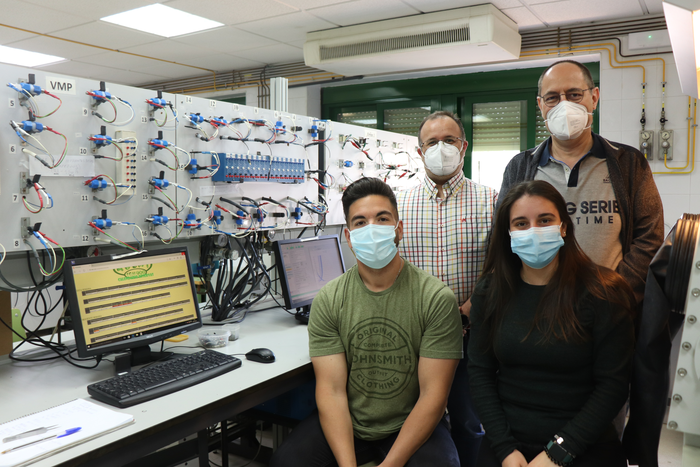On a laboratory scale, the feasibility of magnesium batteries utilizing a new compound as a cathode has been studied by a research group from the University of Córdoba (UCO). This was done in collaboration with the University of Xiamen and the Bulgarian Academy of Sciences.
 Researchers from the University of Cordoba. Image Credit: University of Cordoba.
Researchers from the University of Cordoba. Image Credit: University of Cordoba.
Lithium-ion (Li-ion) batteries have controlled the market to power electronic devices since the 1990s. But this material has been burdened with a few issues, like its scarcity and geographical concentration, primarily discovered in regions of Asia and Latin America.
It has also been shown that the mines from which lithium can be obtained are, at present, unable to fulfill the predictable future demand produced by the increase of electric vehicles.
If we wanted to replace gasoline and diesel vehicles with ones powered by lithium-ion batteries, tomorrow, we wouldn't have enough.
Carlos Pérez-Vicente, Researcher, University of Córdoba
The scientific community has experienced these drawbacks and is hence searching for alternatives to lithium, like sodium, aluminum, magnesium, and calcium.
The FQM288 research team at the UCO has reported their outcomes concerning the viability of magnesium batteries by making use of a new compound (a manganese oxide and magnesium) as a cathode under highly specific conditions (with the cations taking up controlled positions in tetrahedral and octahedral voids). The study was published in the journal Energy Storage Materials.
All batteries are made of 3 elements: a cathode, an anode, and an electrolyte, with their relationship generating the chemical reaction that liberates usable energy. In this study, magnesium metal was utilized as an anode (the battery’s negative pole).
This material has few benefits over lithium: being metallic, it has a bigger capacity compared to the present anodes of Li-ion batteries, and it does not generate dendrites (deposits that impact the safety of the battery, thereby leading to short-circuit). This is something that did happen with the lithium metal batteries.
Producing the reaction is a highly complicated task while magnesium metal has the potential to double the capacity of the batteries.
Not just any material can work with magnesium; there must be theoretical and experimental preliminary studies that lead to success.
Gregorio Ortiz, Researcher, University of Córdoba
Therefore, it is essential to integrate the magnesium metal with an appropriate cathode (the positive pole of the battery). The material utilized by the researchers as a cathode in the study is known as a magnesium manganese oxide, Mg2MnO4, which is given in a stable structure.
This compound brings forth the reduction and oxidation (redox) process by which the energy of the batteries has been produced. In this process, the cathode’s (manganese) metal is reduced and gives up electrons to the metal of the anode (magnesium), which receives them and oxidizes.
The ion transfer is performed via the electrolyte - the third component of the battery, which binds the anode and the cathode. In the study, a non-aqueous electrolyte was utilized, making it possible to function with higher voltages.
The study is a part of the research project that started in 2018 and involves the University of Xiamen, the University of Cordoba, and the Bulgarian Academy of Sciences, thereby mixing theoretical calculations along with an experimental component where methods like X-Ray diffraction, electron microscopy, electronic paramagnetic resonance, and photoelectron spectroscopy have been utilized.
For the success of these scientific advances, interaction with researchers in China and Professor Ortiz’s leadership has been fundamental. They have confirmed that magnesium batteries with the manganese compound helped increase their capacities up to 3.1 V. This implies that their energy density, at the laboratory scale, is around 335 Wh/kg, constituting 60% of lithium-ion batteries’ energy density.
This is an advancement as in earlier studies, a maximum of 2.2 V was never surpassed. But they discovered that in charging and discharging cycles, the batteries saw their initial capacity cut in half.
With new scientific strategies, the initial capacity might be recovered.
Gregorio Ortiz, Researcher, University of Córdoba
The outcomes achieved by the study are hopeful, indicating that batteries that complement lithium ones are possible. But this formula has only just been tested at the laboratory level, so we will have to wait to see how it performs at a real scale, which would need the industry to invest money in the development of such batteries.
Journal Reference:
Ruiz, R., et al. (2022) A Cubic Mg2MnO4 Cathode for non-aqueous Magnesium Batteries. Energy Storage Materials. doi.org/10.1016/j.ensm.2022.02.047.